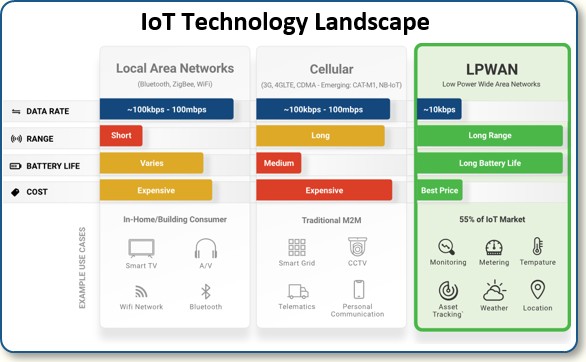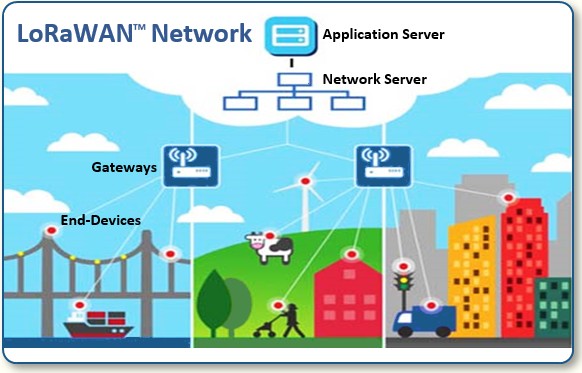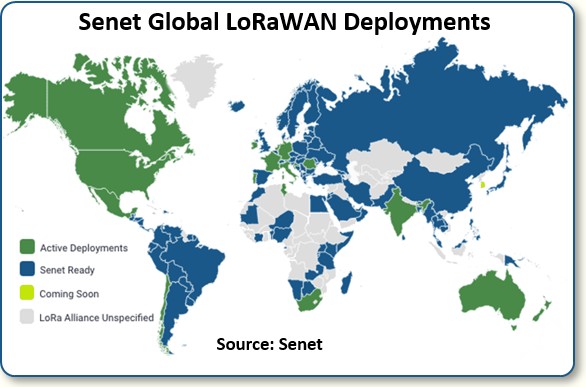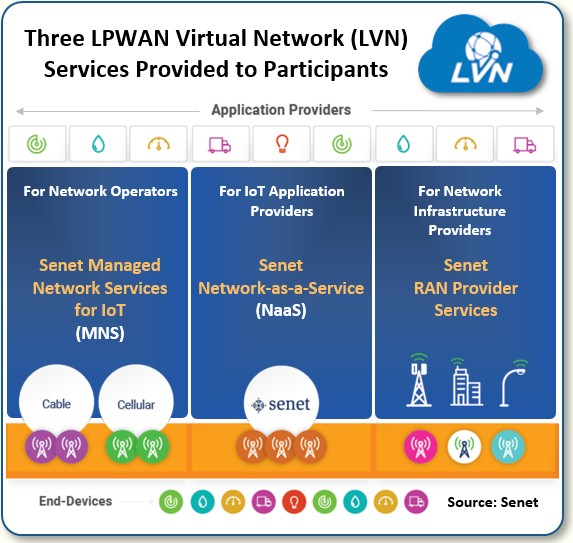| © 2022 Black Swan Telecom Journal | • | protecting and growing a robust communications business | • a service of | |
| Email a colleague |
March 2020
Senet’s Cloud & Shared Gateways Drive LoRaWAN IoT Adoption for Enterprise Businesses, Smart Cities & Telecoms

It’s too bad the biggest cellular technology show, Mobile World Conference, had to be cancelled this year. Yet it’s worth noting the IoT world is by no means locked into traditional cellular technology from 2G to 5G.
One emerging wireless alternative is LoRaWAN (Long Range WAN), an open standard managed by the non-profit LoRa Alliance. The standard uses unlicensed spectrum and the spectrum differs around the world but it’s always free to use.
The designers of LoRaWAN networks didn’t limit themselves to the capabilities of current cellular networks, but looked at the practical requirements of low power, long range IoT applications and designed the wireless standard to fit.
Major success looks like it’s right around the corner. The LoRa Alliance has gained over 500 member companies in just a few years — and big tech firms like Google, Amazon, Cisco, Charter Communications, and Comcast have recently joined.
Here to provide an excellent overview of LoRaWAN is Bruce Chatterley, CEO of Senet, a firm providing cloud-based IoT network services that support a wide range of IoT players from factories, governments, and small businesses to cablecos and mobile phone operators.
What you’ll love about Bruce’s discussion is the way he explains how LoRaWAN fits in the larger IoT ecosystem with plenty of great IoT use case examples. He also describes deployment restraints/costs, and shows how partnering, gateway sharing, and flexible deployment options are paving the way for LoRaWAN to take off.
| Dan Baker, Editor, Black Swan Telecom Journal: Bruce, before you explain Senet’s focus in IoT networking, it might be good to briefly describe the key wireless technologies in use or planned for IoT. It’s quite a mixed bag. |
Bruce Chatterley: It is indeed a mixed bag, Dan. And the reason why several wireless technologies are being used is that no size fits all IoT applications or use cases, as I’ll explain. We think of IoT networking in terms of three main segments:
- Close-In and Powered IoT applications that communicate via Bluetooth, WiFi, and ZigBee;
- High-Bandwidth, Two-Way Communication IoT needed for driverless cars and many of the advanced 5G applications coming; and,
- LPWAN (Low Powered Wide Area Networks) IoT which is characterized by
massively scaled devices. LPWAN is basically about instrumenting the mundane
physical world with unpowered sensors, meaning they run on batteries and are
designed to operate unattended for many years.
LPWAN sensors are often deployed in very hard to reach places. In many instances, once you install a sensor, you generally don’t want to touch it for several years. An example of that is a sensor on a manhole or a utility service line under a city street. If you want to access a street manhole cover in New York City, it might cost tens of thousands of dollars to close the street, hire a police detail, open up the manhole cover and access the service line for repair. You don’t want to incur that expense frequently if it can be avoided.

Click chart above to see the chart at larger scale.
Now focusing on the LPWAN sector alone, there are currently two competing standards:
- Narrowband IOT or NB-IoT is LPWAN based on licensed spectrum, and is what the Tier-1 and Tier-2 wireless carriers are offering. We think NB-IoT is a technology not quite ready for prime-time, as I’ll soon discuss; and,
- LoRaWAN which is an open standard that uses unlicensed spectrum, and pretty much anyone can get into that business. This is the standard Senet supports.
As you look at the size of the IoT market, about 55% of the IoT sensors deployed today are in the LPWAN segment. And as LoRaWAN matures over the next couple years, experts predict the LPWAN market will be pretty evenly split between LoRaWAN and NB-IoT, which is a massive market opportunity given projections for billions of connected devices.
| Please tell us about the origin of LoRaWAN and the IoT applications it was designed for. |
LoRaWAN is clearly the more versatile standard for low power, long range applications. For instance, LoRaWAN works really well when a device requires long-life battery power and long distance communication. The basic infrastructure includes a LoRaWAN gateway (analogous to a base station in the cellular world) and LoRaWAN devices or sensors that can communicate to the gateway from over 80 miles away — making it a very efficient protocol.
When you’re in rural areas managing large farmlands, such as the central valley of California, that performance is essential.
LoRaWAN is good for asset tracking and security applications too. LoRaWAN provides cost and performance advantages for devices in motion — much better than NB-IoT which rapidly eats up battery life — since a device in motion needs to constantly communicate its position back to the base station. It also supports firmware updates over the air in a very efficient manner, which is critical for many applications.
Yesterday we bid on a network for 550,000 meters, each expected to have a 10-year battery life. So if you need to update the device firmware, you can alter all 500,000 meters in a very short period of time in a way that burns very little battery life.
| What about security for these LoRaWAN applications? |
LoRaWAN security is very robust because of the way the protocol implements end-to-end encryption. The data stream gets encrypted at the device and stays encrypted until it reaches the application, the only place with the keys to de-encrypt it.
LoRa’s security policies and capabilities, in fact, extend all the way back to the manufacturer of the device in a secure factory. The keys can be shipped separately from the devices and you can also have a secure process to marry the keys to the devices — and the network takes over from there.
Depending on our customers’ needs, Senet can take additional steps to ensure network security and data privacy through our partnerships with leading security companies, including Atos, Gemalto and G+D Mobile Security.
By contrast, cellular traffic uses hop-by-hop encryption. And that hop-by-hop encryption subjects the data stream to multiple attacks — man in the middle, eavesdropping, etc.
Securing the IoT is of utmost importance to the LoRa Alliance and its member companies and the Alliance maintains a robust set of security information and documentation on its website.
| OK, so LoRaWAN can communicate with sensors 80 miles away, but how about operating in a large city? |
The beauty of LoRaWAN is that it can serve both rural and urban environments well.
In addition to covering large open rural areas, such as California’s central valley which I mentioned earlier, we operate a very dense network in all five boroughs of New York City. You would think New York City’s skyscraper canyons are not particularly friendly to wireless signals, but because of its propagation characteristics, LoRaWAN works well in that type of environment.
One interesting application we support in New York is for the City’s Department of Health where they’ve put LoRaWAN trackers on 5,000 licensed mobile food carts and food trucks located throughout the city.
Each morning health inspectors generate a list of food carts and trucks they want to inspect that day and using the system connected to our network, identify where particular food trucks and carts are parked. They visit each vendor for an unannounced health inspection and give a letter grade on the spot — much like a restaurant health inspection.
Now the network deployed for the Department of Health can become the platform to enable all sorts of private and public utility IoT applications. And we can densify the network as needed and on demand to provide stronger coverage inside buildings, for example.

| How do you actually deploy a LoRaWAN network? |
We deploy gateways on commercial towers, or on top of a building — really, any place a cellular base station can typically be installed.
The gateways provide wireless access for LoRaWAN end devices or sensors and stream their data to Senet’s cloud-based network server via IP backhaul — Ethernet, Wi-Fi, cellular or satellite. That data is made available to all kinds of application platforms via an outbound API from Senet’s cloud services and to the IoT provider’s application. Our cloud-based services allow customers to deploy anywhere and not require network management software on-site to manage their application.
This means if you have an application that gets deployed in 5 cities across the U.S., you can manage the deployment, activation, and ongoing device management all through a single cloud interface.
| This is a nice backgrounder on LoRaWAN. So how did Senet build a business in this IoT sector? |

Well, it all goes back to our roots in 2009 as Enertrac, a company that built an application for propane tank monitoring. We sold this solution to fuel distributors who serviced customers using propane to heat their homes — which typically costs half the amount of electric heat.
We deployed a gateway in the region where a fuel distributor’s customers live and sold a packaged solution including propane tank sensors and the application used to monitor the tank fill level which allowed the distributor to automate the dispatch of fuel trucks to refill those tanks.
This solution allows great cost saving to be achieved because the process automation allowed the distributors to reduce the size of their truck fleet. They maximized profits, and learned, for instance, that 80% empty is the time to send a truck to refill a tank for maximum profitability.
Customer service was also greatly improved because it reduced distress calls from customers concerned that their propane tank was running out of fuel. Customers simply went to an iPhone or web app and could see their consumption rate. This was one of the first IoT success stories in helping modernize a non-technical industry.
As we began to sell this application across the country, we recognized a problem: every time we brought in a new fuel distributor customer, we had to build a new network for their region.
That problem sparked the idea of deploying a national network that could support applications beyond propane distribution. That’s when the umbrella company, Senet, was formed to build a national network for many vertical market applications.
| What are some of the prices, capacities, and use cases around these LoRaWAN networks? |
You can purchase a high-capacity gateway to deploy on a commercial tower or macrocell for about $3,500. That gateway can handle hundreds of thousands of sensor connections. Compare that with cellular which is $60,000 to hundreds of thousands of dollars for a base station.
Last year, we completed over 75 network designs for cities across the U.S for water metering alone. In a city of 100,000 people, you might need 9 gateways on 9 commercial towers. And that would give you outdoor coverage to all the metering kits on the side of homes — and fair indoor coverage too. The meter sensors themselves are sold in the $20 to $25 range. To enhance a location’s indoor coverage, smaller $100 gateways can be deployed.
Now remember, once you’ve deployed a water-metering system with LoRaWAN, that network is available for many other smart city and municipal use cases. Here’s a rundown of some of the popular ones:
- Flood monitoring to monitor rising floodwaters and notify citizens where flooding hazards are impacting homes, businesses, schools, and road conditions.
- Trash monitoring solutions that notify the trash company when a dumpster is ready to be emptied.
- Smart parking applications that monitor and report available parking spots or support no parking enforcement.
- Municipal safety and health applications such as automated lighting, building monitoring, and the food truck solution previously discussed.
- Vehicle tracking in a secure facility such as a shipping port where you want to limit trucks to loading docks and make sure they don’t make stops in unauthorized areas.
- Smart agriculture solutions to maximize crop yield and conserve resources. An example is Sensoterra, our partner out of Holland which makes soil moisture monitors that are hammered into the ground and calculate soil composition, moisture, and help you make better informed decisions about things like irrigation. Another important farm app is rodent control which is being managed with network connected traps and reporting systems.
- Pallet tracking in the supply chain and cold chain is being enabled by extremely small sensors made by firms like Nanothings who have integrated the electronics of a LoRaWAN sensor into biodegradable tape. The sensors are used to record temperature, humidity, and location for chain of custody and produce monitoring applications.

| It’s wonderful to have all these use cases, but you can only address those opportunities if you build networks to reach them. Those networks can be expensive. You can’t pull carts without horses. |
That’s true. We definitely need to scale at low risk and low network expense. But that’s where LoRaWAN networks really shine over the kind of massive “build-it-and-they-will-come” networks deployed in cellular and cable.
The truth is that every application that came to us required some unique geographic coverage or unique propagation. So building a generic network would really only satisfy a portion of the full application and limit the total number of applications that could be supported.
So instead of building prospective networks, our strategy is to use cloud-based services to enable the rapid deployment of IoT networks, but to grow organically: deploy only where the networks are needed.
The secret was to add some financial flexibility and incentives so that Senet customers and allies would serve as network partners.
So how do we incent partners? Well one way we do that is to offer public connectivity. If a customer’s device can see our public network, they can connect at a monthly rate, similar to cellular service.
Second, we made it easier for companies to invest in Senet’s network. For instance, cable, wireless, and other operators came to us saying, “I’ve got IoT opportunities, but I don’t know how to tackle them. These opportunities fit the LPWAN technology, but I don’t want to make a big investment until I know there’s a real market for these IoT apps.”
Well, to address that concern we built a set of products called “Managed Network Services for IoT”. These enable, for example, a cable operator partner to buy the gateways and deploy them on their own assets — towers, aerial cables, and buildings that they own.
Then, as they acquire customers, Senet manages the entire infrastructure on their behalf through our cloud services. If desired, they can insource our services as they get more comfortable and it makes more financial sense for them to spend CAPEX.
Our largest customer under that model is Senra, a company located in India. In the past two years they have deployed our LoRaWAN platform in 52 cities to support IoT applications across India. And they recently started to insource their own capability.
So this plan is working. A major wireless carrier is now deploying a national network on our platform. We are also working with two cable companies that we haven’t announced yet.

| To what extent can IoT operators share these LoRa networks? |
Sharing these networks is the idea behind our LPWAN Virtual Network (LVN). America is a vast country, and no company will deploy a LoRaWAN-based network across the entire U.S. — at least not something dense enough to serve all different IoT applications.
But through our patent-pending LVN technology, we allow Operators and other partners to deploy gateways that connect to the Senet LVN platform. Whoever owns the gateway gets a share of the revenue generated from end-devices that connect to it. So the objective is to crowd-source a national — even global — IoT network that is fully supported by Senet’s network management services and that delivers pervasive and unified connectivity without the need for traditional and costly roaming contracts.
For example, a Senet partner has deployed gateways in a factory for a steam-trap monitoring application and connected them to the Senet LVN. Now another firm can come along and deploy their own sensors using the steam-trap company’s gateways and the steam-trap company collects revenue based on those sensor connections. The owner of the gateway can rapidly recoup the cost of the gateway and create a new recurring revenue stream for their business. Senet manages and rates the quality of service delivery for each participant, ensuring a carrier-grade experience.
| What type of network partners gravitate to these shared gateway services? |
Well, gateway sharing is ideal for cable companies in the U.S. who are landlocked to their franchise area. Cable companies are allowed to deploy networks that cover their cable footprint, but are restricted from selling national applications unless they leverage another companies’ networks. So Senet’s LVN business models and flexibility open that door for them.
Now I think you begin to see how a patchwork quilt of gateways deployed by Senet, cable and wireless firms, and app providers can be woven together via LVN to create a large and dense LoRaWAN network and reward those making the investments.
By the way, this concept is becoming popular in places like Europe, the Middle East and India.
| You’ve talked about a wide range of IoT services where LoRa works. What about something like home security? |
Security alarm panels are usually wired and connect via cellular. But we absolutely can serve home security — or make home security more useful.
What LoRaWAN can do is provide a backup that’s battery powered. So if you lose power the alarms can stay active regardless of what’s happening with the cellular network or wireline network. You can accomplish this by embedding a LoRa chip inside the panel.
Then, once that LoRa capable alarm panel is deployed, you can use that for all kinds of home automation applications. For example, you could do geo-fencing around the home, or put a sensor on your car and whenever that car backs out of your driveway you know your teenager just took off.
You can also do things like leak detection. Once you get the technology in the home, it can deliver all sorts of things. These are highly scalable platforms.
| Bruce, thanks for this beautiful briefing. I can see that LoRaWAN is an IoT network technology with huge potential. And I’m also impressed with Senet’s “quilt works” strategy for bringing in diverse IoT partners. |
Thanks, Dan. We see Senet’s role as creating the software and services to build out these LoRaWAN operator networks. The key is to enable great flexibility — whether we deploy it, another operator deploys it, or an application provider does.
It’s almost a cloud-based network operator because the brains of the operation sits in the cloud and you use physical entities to get the network deployed wherever it’s needed.
Copyright 2020 Black Swan Telecom Journal
Black Swan Solution Guides & Papers
- Expanding the Scope of Revenue Assurance Beyond Switch-to-Bill’s Vision — Araxxe — How Araxxe’s end-to-end revenue assurance complements switch-to-bill RA through telescope RA (external and partner data) and microscope RA (high-definition analysis of complex services like bundling and digital services).
- Lanck Telecom FMS: Voice Fraud Management as a Network Service on Demand — Lanck Telecom — A Guide to a new and unique on-demand network service enabling fraud-risky international voice traffic to be monitored (and either alerted or blocked) as that traffic is routed through a wholesaler on its way to its final destinations.
- SHAKEN / STIR Calling Number Verification & Fraud Alerting — iconectiv — SHAKEN/STIR is the telecom industry’s first step toward reviving trust in business telephony — and has recently launched in the U.S. market. This Solution Guide features commentary from technology leaders at iconetiv, a firm heavily involved in the development of SHAKEN.
- Getting Accurate, Up-to-the-Minute Phone Number Porting History & Carrier-of-Record Data to Verify Identity & Mitigate Account Takeovers — iconectiv — Learn about a recently approved risk intelligence service to receive authoritative and real-time notices of numbers being ported and changes to the carrier-of-record for specific telephone numbers.
- The Value of an Authoritative Database of Global Telephone Numbers — iconectiv — Learn about an authoritative database of allocated numbers and special number ranges in every country of the world. The expert explains how this database adds value to any FMS or fraud analyst team.
- The IPRN Database and its Use in IRSF & Wangiri Fraud Control — Yates Fraud Consulting — The IPRN Database is a powerful new tool for helping control IRSF and Wangiri frauds. The pioneer of the category explains the value and use of the IPRN Database in this 14-page Black Swan Solution Guide.
- A Real-Time Cloud Service to Protect the Enterprise PBX from IRSF Fraud — Oculeus — Learn how a new cloud-based solution developed by Oculeus, any enterprise can protect its PBX from IRSF fraud for as little as $5 a month.
- How Regulators can Lead the Fight Against International Bypass Fraud — LATRO Services — As a regulator in a country infected by SIM box fraud, what can you do to improve the situation? A white paper explains the steps you can and should you take — at the national government level — to better protect your country’s tax revenue, quality of communications, and national infrastructure.
- Telecom Identity Fraud 2020: A 36-Expert Analysis Report from TRI — TRI — TRI releases a new research report on telecom identity fraud and security. Black Swan readers can download a free Executive Summary of the Report.
- The 2021 State of Communications-Related Fraud, Identity Theft & Consumer Protection in the USA — iconectiv — This 49-page free Report on communications-related fraud analyzes the FTC’s annual Sentinel consumer fraud statistics and provides a sweeping view of trends and problem areas. It also gives a cross-industry view of the practices and systems that enable fraud control, identity verification, and security in our “zero trust” digital world.
Recent Stories
- Epsilon’s Infiny NaaS Platform Brings Global Connection, Agility & Fast Provision for IoT, Clouds & Enterprises in Southeast Asia, China & Beyond — interview with Warren Aw , Epsilon
- PCCW Global: On Leveraging Global IoT Connectivity to Create Mission Critical Use Cases for Enterprises — interview with Craig Price , PCCW Global
- Subex Explains its IoT Security Research Methods: From Malware & Coding Analysis to Distribution & Bad Actor Tracking — interview with Kiran Zachariah , Subex
- Mobile Security Leverage: MNOs to Tool up with Distributed Security Services for Globally-Connected, Mission Critical IoT — interview with Jimmy Jones , Positive Technologies
- TEOCO Brings Bottom Line Savings & Efficiency to Inter-Carrier Billing and Accounting with Machine Learning & Contract Scanning — interview with Jacob Howell , TEOCO
- PRISM Report on IPRN Trends 2020: An Analysis of the Destinations Fraudsters Use in IRSF & Wangiri Attacks — interview with Colin Yates , Yates Consulting
- Telecom Identity Fraud 2020: A 36-Expert Analyst Report on Subscription Fraud, Identity, KYC and Security — by Dan Baker , TRI
- Tackling Telecoms Subscription Fraud in a Digital World — interview with Mel Prescott & Andy Procter , FICO
- How an Energized Antifraud System with SLAs & Revenue Share is Powering Business Growth at Wholesaler iBASIS — interview with Malick Aissi , iBASIS
- Mobileum Tackles Subscription Fraud and ID Spoofing with Machine Learning that is Explainable — interview with Carlos Martins , Mobileum


